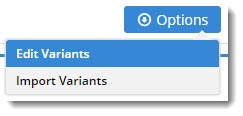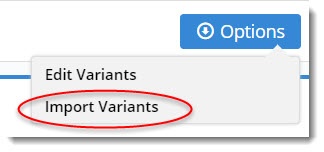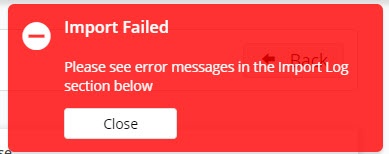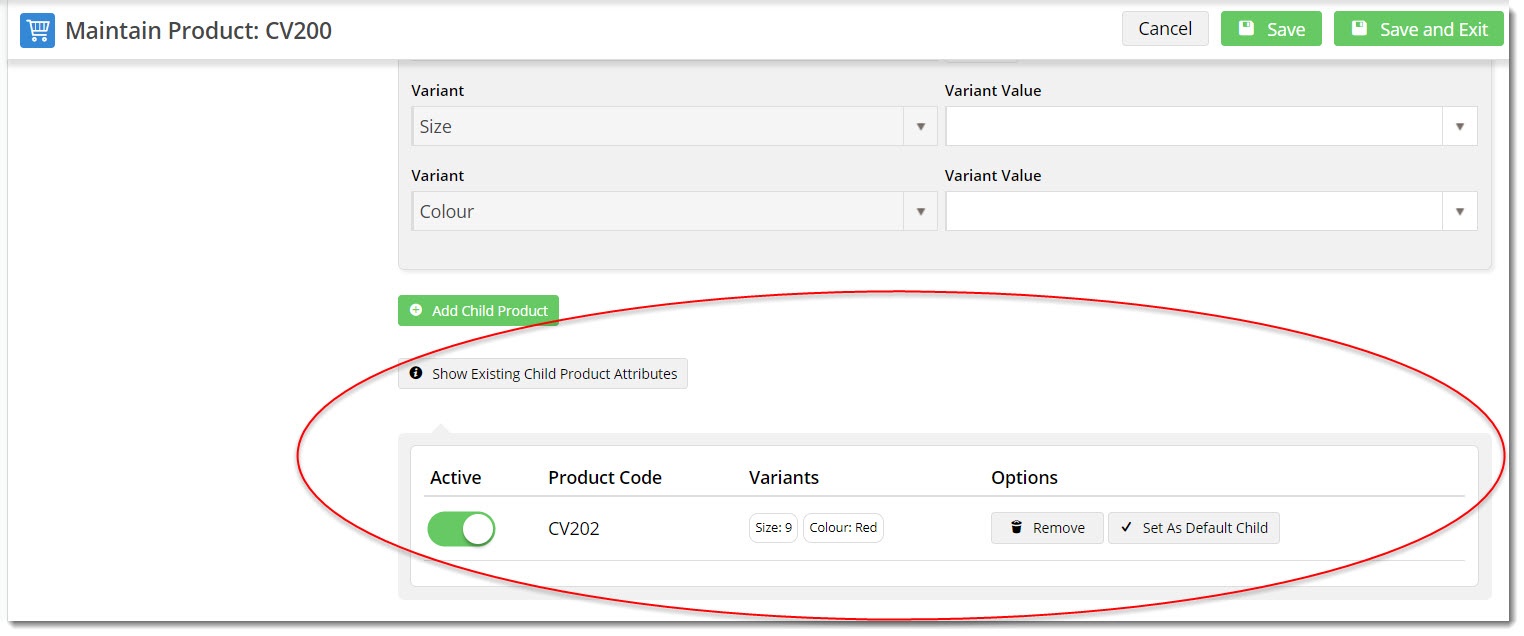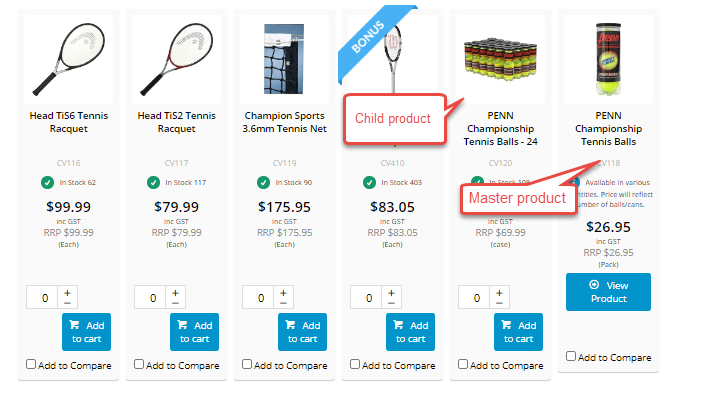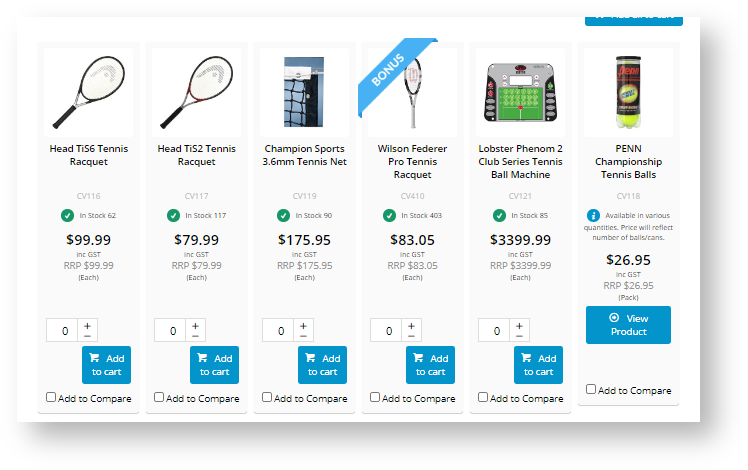Overview
Product Variants allows you to organise certain products as variants of a single master product for online display and search purposes on your site. Let's use an example to explain the feature, for instance, with a Colour / Size scenario.
Imagine that product CV149 is a High-vis Safety Vest. It's available in several different sizes and colours:
- 'CV149SMYY' might represent size small, colour yellow
- 'CV149MDYY' is size medium, colour yellow.
- In fact, when you list all the possible colour and size combinations, you might have upwards of 20 SKUs just for this one product.
But uploading and maintaining 20+ variations for dozens of products on your site isn't very efficient. The end result would probably overwhelm your customers, too. That's where Product Variants come in.
Instead of putting all 20+ variations on the web, you can display one product (the 'master') online, and then allow your customers to select from available variants (the 'child' products).
Prerequisites
- Product Variant needs to be enabled by Commerce Vision.
- If you want the option of hiding each variant product from appearing in search results on your site (see 'Hide Child Products from Product Search' below), let us know so we can enable it.
1. Configure Product Variant Settings
This guide will step you through the process of maintaining variants online via the CMS. First, you'll want to ensure the Product Variant feature is configured correctly for your site.
- In the CMS, navigate to Settings → Feature Management.
- In Products & Categories → Product Variants, ensure it is toggled on and click Configure.
- Switch the Product Variant Mode to 'Online'.
- 'Default Display Type' sets the interface for users when they are selecting options. Select 'DropDown' or 'Radio Buttons'.
- 'Allow Product Matrix Mode' allows individual products to be set to matrix display mode, using the Product Variant Grid Widget. Toggle on/off as required.
- 'Allow Display Type Override' allows the default display type (that you just set in Step 4) to be overridden on a product-by-product basis. Toggle on/off as required.
- 'Allow Child Products As Note Line' allows child products to be added without a product code. Instead, the selected variants are added as notes against the master product on the order. Toggle on/off as required.
- 'Enforce Stock Security for Variants' allows stock security settings for each child product to apply. Toggle on/off as required.
- 'Update Master Products With Child Images' adds child images to the master product gallery automatically, so that as the user selects different options, the image will change to reflect them. Toggle on/off as required.
- See our guide on Automatic image tagging for variants for further details.
11. 'Allow Manual Sort of Products Attributes' allows the user to sequence product attributes by drag-and-drop. Toggle on/off as required.
12. Toggle 'Enforce Tag Order Comparison' on/off as required.
13. Click 'Save'.
The Product Variant feature has now been configured and is ready to use during product maintenance.
2. Edit Site-Wide Variants (optional)
The CMS stores a site-wide list of Variants (for example, 'Size') and their associated Values ('Small', 'Medium', 'Large') in a table. This lookup table is referenced when you add a child product to a master.
You can enter new variants and values directly on the Product Maintenance screen when you're setting up products, so this step is not mandatory. New variant/values entered in the Product Maintenance page will automatically be added to the list here, but you may need to come here to edit or correct existing options.
- In the CMS, navigate to Settings → Feature Management → Products & Categories.
- Configure the Product Variant feature.
Hover over the Options button and select Edit Variants.
Don't see an 'Options' button? Check that the Product Variant Mode is set to 'Online', then click Save.
- Click Add and enter a Variant in the input field. In our example we'll add 'Size' as a variant.
- Click Save. You'll notice the button updates from 'Save' to 'Values'.
- Click Values and then Add to add a value. Our example values for 'Size' are 'Small', 'Medium', and 'Large'.
- Click Save and repeat to add another value. Continue until all values have been entered.
- Click Back to exit values maintenance and return to your Variant list.
- You can repeat this process for any other Variants you may require, such as Colour, Capacity, Weight, Length, and so on.
If you are running version 4.13.00 or later, you can configure your CMS to enable repositioning of your master product variants by dragging each variant in the order you want in the list. Refer to the
Manually Sort the Product Variants in CMS knowledge base article.
3. Add Child Products (Variants) to Master Products
Now let's set up some variants to a Master product!
- In the CMS, navigate to Products & Categories → Product Maintenance.
- Search for the required product and click Edit.
- At the bottom of the maintenance page, you'll find a section labelled 'Master Product'.
- Toggle 'Is Master Product' on. The Child Products section with additional maintenance fields will appear.
- To add the first child, either search for the product code to be used as the child SKU, or leave blank to use the master code for pricing. Note - you can only leave this blank if 'Allow Child Products As Note Line' is enabled in Feature Settings.
- Enter the Variant name in the first Variant box. The dropdown list will be populated as you type, with data if these were added earlier (see section 2 above).
- Select the correct option from the list, or simply enter a new one.
- Next, enter the Variant Value in the corresponding box. The dropdown list will be populated from values in the lookup table and any there were previously entered here.
- If there is another variant applicable to this product, enter it in the next line, repeating steps 7 -9.
- If there is a third variant dimension available, click the Add Variant button.
- Once all variants have been entered, click Add Child Product.
- If this child product is to be the default variant displayed in the Product List and Product Details pages, click 'Set as Default Child' to on.
- REMEMBER - save any work done to the Master Product section. Click Save at the top of the maintenance page.
The child product will now be listed below in 'Show Existing Child Product Attributes', along with options to make it active/inactive, remove it or set it as the default child product.
When a product is a child, a message appears on the top of its Product Maintenance page, to alert users that the product is a variant. Its Master product(s) are also listed. You can click on the Master Product name to access its Product Maintenance page.
Making a child product active/inactive
A child product can be marked 'inactive' but remain a child of the Master product. For example, a particular variant might become temporarily unavailable so you do not want your customers to see this variant for the time being.
- If you are already in the 'Master Product' section for the Master product, go to step 4. Otherwise, navigate to Products & Categories → Product Maintenance, find the master product and click Edit.
- Scroll down to the 'Master Product' section.
- Click 'Show Existing Child Product Attributes'.
- Toggle off 'Active' for that child product. You can toggle 'Active' on again at any time.
- Click Save at the top of the page.
Removing a child product from a Master product
Removing a child product deletes it permanently as a variant of a Master product.
- If you are already in the 'Master Product' section for the Master product, go to step 4. Otherwise, navigate to Products & Categories → Product Maintenance, find the master product and click Edit.
- Scroll down to the 'Master Product' section.
- Click 'Show Existing Child Product Attributes'.
- Click Remove for the child product.
- Click Save at the top of the page.
Importing Product Variants
To perform a bulk upload of product variant data, you can use the import function.
- Navigate to Settings → Feature Settings and Edit the Product Variant feature.
- Select Options → Import Variants.
- If you would like a CSV file template to work with, click Download Example Template.
- Paste your data into the spreadsheet, re-entering the master product once for every variant combination available.
- Save the file somewhere locally as .csv format.
- Select your Import Type from the dropdown:
a. Override Imported Only - all master products in the spreadsheet will have their variant data replaced with what's in your spreadsheet. No other products will be affected.
b. Override All Products - the product data in in the spreadsheet will become the COMPLETE product variant data for your site. Current variants not in the spreadsheet will be deleted.- Click 'Select files...' to browse to your saved .csv file.
- The import will process and a notification will advise whether the import was successful. If errors occurred, fix the data and try again.
- To verify a successful import, navigate to Product Maintenance and search for one of the master products on your .csv file.
- Check the variant data to ensure it matches up with what you've just imported.
Hide Child Products from Product Searches (optional)
When a site visitor performs a product search on your site, the default option is to list the master product and any child products with their own product codes:
Another option is to have child products hidden from search results. When this setting is switched on, only the Master product will be listed:
When this option is switched on, next to the 'Display Online' toggle in the Product Maintenance page, the following message will appear:
Switch On/Off Hide Child Products from Searches
If you prefer to have child products hidden from search results switched on or off for your site, please contact CV support.
Related help
Additional Information
--
| Minimum Version Requirements |
|
|---|---|
| Prerequisites |
|
| Self Configurable |
|
| Business Function |
|
| BPD Only? |
|
| B2B/B2C/Both |
|
| Ballpark Hours From CV (if opting for CV to complete self config component) |
|
| Ballpark Hours From CV (in addition to any self config required) |
|
| Third Party Costs |
|
| CMS Category |
|


